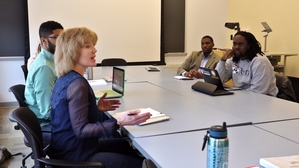PennAHEAD report finds gap in degree attainment between rich and poor families rising
Students from the wealthiest families in the United States are eight times more likely to earn a bachelor’s degree by age 24 than their counterparts from the lowest earning families.
That reality — detailed in a new report released Tuesday by the Pell Institute and Penn GSE’s Alliance for Higher Education and Democracy (PennAHEAD) — is one factor driving growing economic inequality, according to PennAHEAD director Laura Perna

Professor Laura Perna teaches in the Higher
Education Division at Penn GSE.
The struggle for those in low-income families to complete a college education clouds the report’s positive news that today’s students are much more likely to earn a traditional bachelor’s degree than students 40 years ago.
But those gains have been significantly concentrated among upper-income families, the report found.
When students from low-income families do enroll in post-secondary education, they are much more likely to attend two-year rather than four-year institutions, and those schools are more likely to be for-profit instead of non-for-profit.
“Not everyone needs a college degree, of course,” Perna writes in the report, “but far too few people in the United States—and especially far too few people from groups that are historically underrepresented in college—are getting one.”
